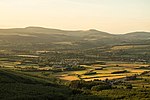Craig y Llyn
Highest points of Welsh countiesMarilyns of WalesMountains and hills of Rhondda Cynon TafPages with Welsh IPASites of Special Scientific Interest in Rhondda Cynon Taf

Craig y Llyn (Welsh, 'rock/cliff of the lake') is a mountain situated to the south of the village of Rhigos in the Cynon Valley on the south side of the upper Vale of Neath and north of the Rhondda Valleys in South Wales; it is the highest point in the ancient kingdom and, later, county of Glamorgan (Morgannwg), and the southern Welsh coalfield plateau.
Excerpt from the Wikipedia article Craig y Llyn (License: CC BY-SA 3.0, Authors, Images).Craig y Llyn
Riding High,
Geographical coordinates (GPS) Address Nearby Places Show on map
Geographical coordinates (GPS)
| Latitude | Longitude |
|---|---|
| N 51.71592 ° | E -3.58497 ° |
Address
Riding High
CF44 9HX , Blaengwrach
Wales, United Kingdom
Open on Google Maps





